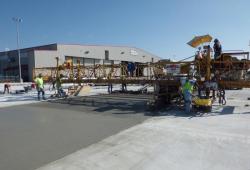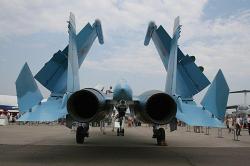What is the difference between conventional and Sukhoi fighter aircraft?
When comparing conventional fighter aircraft to Sukhoi fighter aircraft, it's important to note that "conventional" is a broad term that encompasses a variety of aircraft from different manufacturers. The term "Sukhoi" specifically refers to a series of fighter aircraft designed and produced by the Russian company Sukhoi. To provide a general comparison, let's contrast the characteristics of a typical Western conventional fighter (such as those from NATO countries) with Sukhoi fighter aircraft:
1. Origin and Manufacturers:
Conventional Fighters:
- Conventional fighters may come from various Western manufacturers, including companies from the United States, the United Kingdom, France, and others. Examples include the F-16, F-18, Eurofighter Typhoon, and Rafale.
Sukhoi Fighters:
- Sukhoi is a Russian aerospace company known for producing a series of fighter jets. Examples include the Sukhoi Su-27, Su-30, Su-35, and the fifth-generation Su-57.
2. Design Philosophy:
Conventional Fighters:
- Western fighters often emphasize versatility, multi-role capabilities, and technological innovation. They may incorporate advanced avionics, stealth features, and a high level of integration with network-centric warfare systems.
Sukhoi Fighters:
- Sukhoi fighters are known for their agility, speed, and powerful engines. They often feature advanced aerodynamics, long-range capabilities, and a focus on air superiority. Sukhoi aircraft are also known for their robust design, suitable for a variety of combat scenarios.
3. Aerodynamics and Maneuverability:
Conventional Fighters:
- Western fighters often incorporate advanced aerodynamics for agility and maneuverability. Some fighters, like the Eurofighter Typhoon, are known for their exceptional agility.
Sukhoi Fighters:
- Sukhoi fighters are renowned for their exceptional maneuverability. The Su-27 family, for example, is known for its high thrust-to-weight ratio and impressive dogfighting capabilities.
4. Thrust Vectoring:
Conventional Fighters:
- Some Western fighters, like the F-22 Raptor, incorporate thrust vectoring technology for enhanced agility and control.
Sukhoi Fighters:
- Many Sukhoi fighters, including the Su-30 and Su-35, feature thrust vectoring nozzles, allowing for precise control of the aircraft's direction.
5. Stealth Features:
Conventional Fighters:
- Some Western fighters, like the F-35 Lightning II, are designed with stealth features to reduce radar cross-section and enhance survivability in contested environments.
Sukhoi Fighters:
- Sukhoi's focus has been more on agility and air dominance rather than on stealth. However, the fifth-generation Su-57 incorporates some stealth characteristics.
6. Export Market:
Conventional Fighters:
- Western fighters are commonly exported to various countries around the world, and they often participate in multinational defense partnerships.
Sukhoi Fighters:
- Sukhoi fighters, especially the Su-30 and Su-35, are popular choices for export to a variety of countries. The Su-57 is positioned as a fifth-generation fighter for both the Russian Air Force and potential export markets.
7. Operational Use:
Conventional Fighters:
- Western fighters are widely used by NATO countries and other allies in a range of roles, including air superiority, ground attack, and reconnaissance.
Sukhoi Fighters:
- Sukhoi fighters are operated by the Russian Air Force and have been exported to numerous countries. They are designed for air superiority, and some models, like the Su-34, also serve in a ground-attack role.
In summary, the comparison between conventional and Sukhoi fighter aircraft involves considering the specific models and their respective design philosophies. Conventional fighters from Western countries often emphasize versatility, advanced technology, and multi-role capabilities, while Sukhoi fighters are known for their agility, air superiority focus, and powerful engines. The specific characteristics can vary significantly between individual aircraft models within each category.
Overview of conventional fighter aircraft design and characteristics
Conventional fighter aircraft are designed to achieve air superiority, which means they are capable of engaging and defeating enemy aircraft in aerial combat. They typically have a high thrust-to-weight ratio, which allows them to maneuver quickly and aggressively. They are also equipped with powerful engines and advanced avionics, which provide them with the speed, agility, and situational awareness they need to engage and defeat enemy aircraft.
Conventional fighter aircraft typically have the following characteristics:
High Thrust-to-Weight Ratio: This allows for rapid acceleration, high climb rates, and excellent maneuverability.
Powerful Engines: Provide the necessary thrust for achieving high speeds and altitudes.
Advanced Avionics: Include radar, targeting systems, and electronic warfare suites for situational awareness and combat effectiveness.
Aerodynamic Design: Optimized for high-speed flight and maneuverability.
Armament: Comprises air-to-air missiles, cannons, and sometimes bombs for engaging enemy aircraft and ground targets.
Key features and capabilities of Sukhoi fighter aircraft
Sukhoi fighter aircraft are renowned for their exceptional maneuverability, powerful engines, and advanced avionics. They have played a significant role in the development of fighter aircraft technology and have been instrumental in shaping global airpower dynamics.
Key features and capabilities of Sukhoi fighter aircraft include:
High Maneuverability: Sukhoi fighters are known for their ability to perform high-G maneuvers, making them difficult to evade in aerial combat.
Powerful Engines: Sukhoi aircraft typically feature powerful engines that provide exceptional thrust-to-weight ratios, enabling high speeds and rapid acceleration.
Advanced Avionics: Sukhoi fighters are equipped with sophisticated avionics suites that enhance situational awareness and combat effectiveness.
Diverse Configurations: Sukhoi produces a range of fighter aircraft, from lightweight single-engine fighters to multirole twin-engine fighters, each with its unique capabilities.
Comparative analysis of conventional and Sukhoi fighter aircraft
While conventional fighter aircraft share many common characteristics, Sukhoi fighters stand out for their exceptional maneuverability, powerful engines, and advanced avionics.
| Feature | Conventional Fighter Aircraft | Sukhoi Fighter Aircraft |
|---|---|---|
| Thrust-to-weight ratio | High | Exceptional |
| Engine power | Powerful | Generally more powerful |
| Avionics | Advanced | Highly sophisticated |
| Maneuverability | Good | Exceptional |
| Configurations | Diverse range | Wide variety of configurations |
Evolution of Sukhoi fighter aircraft design and technology
Sukhoi fighter aircraft have undergone continuous evolution since the company's inception in 1939, constantly pushing the boundaries of fighter aircraft design and technology.
Key milestones in the evolution of Sukhoi fighter aircraft include:
1940s: Sukhoi's early fighters, like the Su-2 and Su-7, established the company's reputation for producing agile and capable aircraft.
1950s: The introduction of the Su-9 and Su-11 marked a shift towards supersonic fighters, further enhancing Sukhoi's technological prowess.
1960s and 1970s: The development of the Su-15 and Su-27 solidified Sukhoi's position as a leading fighter aircraft manufacturer.
1980s and 1990s: The Su-27 Flanker and its variants became renowned for their exceptional maneuverability and air superiority capabilities.
2000s and Present: Sukhoi continues to innovate with advanced fighters like the Su-35 Flanker-E and the Su-57 Felon, incorporating stealth technology and advanced avionics.
Impact of Sukhoi fighter aircraft on global airpower dynamics
Sukhoi fighter aircraft have played a significant role in shaping global airpower dynamics, influencing the development of fighter aircraft technology and influencing military strategies worldwide.
Technological Advancement: Sukhoi's constant pursuit of innovation has driven the development of fighter aircraft technology, pushing the boundaries of performance and capability.
Military Strategies: The presence of Sukhoi fighter aircraft in various air forces has influenced military strategies, emphasizing the importance of air superiority and advanced fighter capabilities.
Global Airpower Balance: Sukhoi fighter aircraft have contributed to the balance of global airpower, influencing military deployments and strategic alliances.








